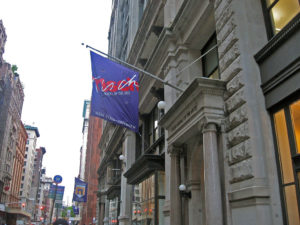As a first-year at Pace University in New York, 18-year-old Ammarie Grassle discovered liberal arts education was not for her.
Like thousands of students every year who opt to spend much of their high school experiences toiling in endless rehearsals, poorly staged Broadway revivals and summertime theater camps, she wanted to spend more time on the stage and less time contemplating math problems.
She started looking into musical theater conservatories, such as Collaborative Arts Project for the 21st Century, located in Manhattan. Grassle, now 24, has not once regretted the decision since she graduated from CAP21, which offers training in musical theater, in 2015.
“I didn’t know about conservatories before Pace,” said Grassle. “I was at Pace and I hated it so much, mostly because of the general education classes. The theater department was incredible, but also not personal.”
As with most tough decisions, there are pros and cons to forgoing a traditional associate or bachelor of arts degree for targeted training. Conservatory programs are often offshoots of traditional colleges, such as Tisch School of the Arts, which is affiliated with New York University.
At conservatories, there is much more emphasis on music and performing than core academic coursework, as with a liberal arts degree, meaning the focus is all performance all the time. In 2017, the National Association of Schools of Music counted 650 accredited conservatories in the United States.
Liberal arts colleges, on the other hand, allow students to expand their knowledge of other subjects, such as history or English, which can end up helping a performer in the long run. Such programs also allow for majors and minors, which gives students a backup as they enter into a notoriously difficult career.
Grassle and her boyfriend, Adam Brewer, 22, both graduated from CAP21, though Brewer started a year after Grassle and graduated in 2016. Formerly partnered with Tisch School of the Arts, itself a conservatory program, CAP21 has since partnered with Molloy College for financial reasons. When Grassle and Brewer attended the school, it was a two-year program.

Most conservatory programs hold auditions for students to qualify for admissions. Grassle went to a Unifieds, where dozens of conservatories hold auditions for future students at the same time. Auditions are extremely short, with many of them being several seconds. There are four locations for Unifieds auditions each year: Chicago, Las Vegas, Los Angeles and New York.
There are about 30 official Unifieds members, but any conservatory can sign up to have students audition, and many do. Students must generally sign up in advance for each audition, although several schools also have walk-up audition slots available.
It was at Unifieds that Grassle discovered CAP21, auditioning for the program as well as for multiple other conservatories.
Brewer, on the other hand, had gone to a summer training program at CAP21 before his senior year of high school and knew that CAP21 was a perfect fit.
“It was an environment that was really conducive to productivity,” Brewer said.
At CAP21, students often worked from morning to all hours of the night, rehearsing for shows and assignments.
“That was one of the biggest draws of a conservatory for me,” said Brewer. “They strip away everything that isn’t necessary. And then they run you ragged.”
Conservatory graduates enter a highly competitive business. Many aspiring actors never get cast in commercials, much less star in a Broadway musical. But for those determined to fulfill their dreams, research shows conservatory programs can provide an edge.
It is not just that conservatory students get specialized training to do what they love, but they are more likely to make more money doing it than their non-conservatory counterparts, as well. A 2012 study by The Future of Music Coalition found that conservatory graduates make an average of $41,600 annually and work 32.5 hours a week compared to their non-conservatory counterparts, who make $25,200 and work 26 hours a week.
Conservatory graduates were also more likely to perform live, be a member of an orchestra, participate in an ensemble and to get a graduate degree, by a rate of 46 percent to 22 percent.
The most popular post-conservatory job was teaching. Approximately 30 percent of graduates go on to teach, and over 70 percent of those students said they taught private lessons. Many of the students interviewed said they both taught and performed simultaneously.
“It just kind of opened the door to getting a job right after graduation, which is what everyone wants,” said Grassle. “Especially when you graduate in May and shows are weeks away.”
Neither Brewer nor Grassle have Broadway ambitions. Grassle is a model and Brewer is a musician. They said that many of their classmates diverge from acting or singing, as well, hoping to direct or go elsewhere in the performing arts world.
Nonetheless, they say they do not regret attending a conservatory. Both of them feel they got a lot out of their education for the paths they are now pursuing.
“Especially for me, there were business classes,” said Grassle. “It was musical theater business, but it’s still all connected. Even modeling, there are casting calls. I still have to go to backstage.com. I learned all of that through those classes.”

Their connections to the performing arts world cannot hurt, either. That can be the hardest part, according to Rebecca Overton, the theater arts recruitment coordinator at CAP21/Molloy.
Even for artists who have gotten jobs before, she said, there is no guarantee they will get them again. Overton herself had a hard time booking jobs for a while, even though she had been successful early on.
“That is where the conservatory connections really help,” said Overton.
Overton attended Providence College in Rhode Island as an English major, only auditioning for shows after graduation. It is a decision that would have been different had she known what her future would look like.
“If I had known that I was going to do this as a career, I would have gone to a conservatory,” she said.
Overton joined the CAP21/Molloy team last year. The conservatory is located in the financial district in New York City, while the Molloy campus is in Rockville Center in Long Island, meaning students take their core classes at Molloy and head into the city for training and rehearsal.
Molloy is a private Catholic college with about 4,900 undergraduate, graduate and doctoral students. Founded in 1955, it officially became Molloy College in 1971.
Although students have to take the train back and forth from New York City to Long Island if they want to be a part of the CAP21 program, Overton said that being in New York is worth it.
“Our students have kind of a gentle springboard into Manhattan life,” which is where many of them want to end up, said Overton. “Every week, they have a new industry person coming in.”
According to Overton, CAP21’s two-year program was floundering financially, leading to a partnership with Molloy.
“It’s kind of a hard sell to charge basically college prices without a degree,” Overton said, referring to the certificates the conservatory awarded instead. “(And) Molloy was looking for a theater program.”
It is a program Brewer and Grassle may not have chosen at all, had they been looking to attend a conservatory today. Instead of a two-year program, CAP21/Molloy is now four years, requiring more traditional coursework.
Overton said that one of the draw-backs of a conservatory is that most of the people who do them are still very young and are expected to decide what they want to do with the rest of their lives.
To do a two-year program, especially, the student must be entirely dedicated to performing. If they decide several years down the road that they want to do something else, “they are basically back at square one,” said Overton.
Overton concedes, however, that a two-year program is a great option for many.
“It’s like a trade school,” she said. “Academics aren’t for everyone.”

For Emily Knutsson, 17, the obvious choice was not a conservatory, but a liberal arts degree. Knutsson will graduate from John Jay High School this spring and plans on studying history and law at either the University of Edinburgh or the University College London.
Though she considered applying to Tisch School of the Arts, she ultimately decided against it. She ended up only applying to liberal arts colleges, even though she wants to do theater long term.
“It’s so expensive,” said Knutsson. “It’s the same price as a normal college education.”
The average cost of a liberal arts college at a private institution during the 2014-15 school year was $31,231, although most traditional colleges and conservatories offer financial aid. For that much money, Knutsson said, she wants to focus on more than theater. She loves history, and believes studying it will make her a better actor.
Still, she definitely plans on pursuing her passion while in school. Many of the conservatory programs Knutsson researched advise against students auditioning for jobs outside of the school. Although Grassle said that she and many of her fellow classmates were told to audition during their programs, many were not. Knutsson wants to know for sure that she will be free to explore her options.
“I’d love to work in the real world and gain experience,” Knutsson said.

